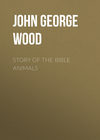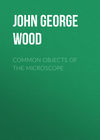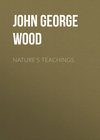Czytaj książkę: «Story of the Bible Animals», strona 33
"At once the young one commenced shaking the bough and screaming with all his might, to attract the attention of the Crocodile and to induce it to move. In this he was immediately joined by the whole party, who yelled in chorus, while the large old males bellowed defiance, and descended to the lowest branches within eight or ten feet of the Crocodile. It was of no use—the pretender never stirred, and I watched it until dark. It remained still in the same place, waiting for some unfortunate baboon whose thirst might provoke his fate, but not one was sufficiently foolish, although the perpendicular bank prevented them from drinking except at that particular spot."
It may be imagined that if the Crocodile were to depend entirely for its food upon the animals that it catches on the bank or in the river, it would run a risk of starving. The fact is, that its principal food consists of fish, which it can chase in the water. The great speed at which the Crocodile darts through the water is not owing to its webbed feet, but to its powerful tail, which is swept from side to side, and thus propels the reptile after the manner of a man "sculling" a boat with a single oar in the stern. The whales and the fishes have a similar mode of propulsion.
On land, the tail is the Crocodile's most formidable weapon. It is one mass of muscle and sinew, and the force of its lateral stroke is terrible, sweeping away every living thing that it may meet. Fortunately for its antagonists, the Crocodile can turn but very slowly, so that, although it can scramble along at a much faster pace than its appearance indicates, there is no great difficulty in escaping, provided that the sweep of its tail be avoided. As the Crocodile of the Nile attains when adult a length of thirty feet, one moiety of which is taken up by the tail, it may easily be imagined that the power of this weapon can scarcely be exaggerated.
As if to add to the terrors of the animal, its head, back, and tail are shielded by a series of horny scales, which are set so closely together that the sharpest spear can seldom find its way through them, and even the rifle ball glances off, if it strikes them obliquely. Like many other reptiles, the Crocodile is hatched from eggs which are laid on shore and vivified by the warmth of the sun.
These eggs are exceedingly small when compared with the gigantic lizard which deposited them, scarcely equalling in dimensions those of the goose. There is now before me an egg of the cayman of South America, a fresh-water lizard but little smaller than the Crocodile of the Nile, and this is barely equal in size to an ordinary hen's egg. It is longer in proportion to its width, but the contents of the two eggs would be as nearly as possible of the same bulk. On the exterior it is very rough, having a granulated appearance, not unlike that of dried sharkskin, and the shell is exceedingly thin and brittle. The lining membrane, however, is singularly thick and tough, so that the egg is tolerably well defended against fracture.
When first hatched, the young Crocodile is scarcely larger than a common newt, but it attains most formidable dimensions in a very short time. Twenty or thirty eggs are laid in one spot, and, were they not destroyed by sundry enemies, the Crocodiles would destroy every living creature in the rivers. Fortunately, the eggs and young have many enemies, chiefly among which is the well-known ichneumon, which discovers the place where the eggs are laid and destroys them, and eats any young Crocodiles that it can catch before they succeed in making their way to the water.
The old writers were aware of the services rendered by the ichneumon, but, after their wont, exaggerated them by additions of their own, saying that the ichneumon enters into the mouth of the Crocodile as it lies asleep, and eats its way through the body, "putting the Crocodile to exquisite and intolerable torment, while the Crocodile tumbleth to and fro, sighing and weeping, now in the depth of water, now on the land, never resting till strength of nature faileth. For the incessant gnawing of the ichneumon so provoketh her to seek her rest in the unrest of every part, herb, element, throws, throbs, rollings, but all in vain, for the enemy within her breatheth through her breath, and sporteth herself in the consumption of those vital parts which waste and wear away by yielding to unpacificable teeth, one after another, till she that crept in by stealth at the mouth, like a puny thief, comes out at the belly like a conqueror, through a passage opened by her own labour and industry."
The author has in the long passage, a part of which is here quoted, mentioned that the ichneumon takes its opportunity of entering the jaws of the Crocodile as it lies with its mouth open against the beams of the sun. It is very true that the Crocodile does sleep with its mouth open; and, in all probability, the older observers, knowing that the ichneumon did really destroy the eggs and young of the Crocodile, only added a little amplification, and made up their minds that it also destroyed the parents. The same writer who has lately been quoted ranks the ibis among the enemies of the Crocodile, and says that the bird affects the reptile with such terror that, if but an ibis's feather be laid on its back, the Crocodile becomes rigid and unable to move. The Arabs of the present time say that the water-tortoises are enemies to the eggs, scratching them out of the sand and eating them.

ICHNEUMON DEVOURING THE EGGS OF THE CROCODILE.
As this reptile is so dangerous a neighbour to the inhabitants of the river-banks, many means have been adopted for its destruction.
One such method, where a kind of harpoon is employed, is described by a traveller in the East as follows:—
"The most favourable season for thus hunting the Crocodile is either the winter, when the animal usually sleeps on sand-banks, luxuriating in the rays of the sun, or the spring, after the pairing time, when the female regularly watches the sand islands where she has buried her eggs.
"The native hunter finds out the place and conceals himself by digging a hole in the sand near the spot where the animal usually lies. On its arrival at the accustomed spot the hunter darts his harpoon or spear with all his force, for, in order that its stroke may be successful, the iron should penetrate to a depth of at least four inches, in order that the barb may be fixed firmly in the flesh.
"The Crocodile, on being wounded, rushes into the water, and the huntsman retreats into a canoe, with which a companion has hastened to his assistance.
"A piece of wood attached to the harpoon by a long cord swims on the water and shows the direction in which the Crocodile is moving. The hunters pull on this rope and drag the beast to the surface of the water, where it is again pierced by a second harpoon.
"When the animal is struck it by no means remains inactive; on the contrary, it lashes instantly with its tail, and endeavours to bite the rope asunder. To prevent this, the rope is made of about thirty separate slender lines, not twisted together, but merely placed in juxtaposition, and bound around at intervals of every two feet. The thin strands get between the Crocodile's teeth, and it is unable to sever them.
"In spite of the great strength of the reptile, two men can drag a tolerably large one out of the water, tie up his mouth, twist his legs over his back, and kill him by driving a sharp steel spike into the spinal cord just at the back of the skull.
"There are many other modes of capturing the Crocodile, one of which is the snare portrayed in the illustration.

A CROCODILE TRAP
"Two elastic saplings are bent down and kept in position by stout cords, one of which, bears a baited hook, while the other is fashioned into a noose. These cords are so arranged as to release the bent saplings as soon as the Crocodile pulls upon the baited hook. If all works properly, the animal suddenly finds himself suspended in the air, where he remains helpless and at the mercy of the hunter, who soon arrives and despatches him.
"The extreme tenacity of life possessed by the Crocodile is well exemplified by an incident which occurred in Ceylon. A fine specimen had been caught, and to all appearance killed, its interior parts removed, and the aperture kept open by a stick placed across it. A few hours afterwards the captors returned to their victim with the intention of cutting off the head, but were surprised to find the spot vacant. On examining the locality it was evident that the creature had retained sufficient life to crawl back into the water. From this it may be imagined that it is no easy matter to drive the breath out of a Crocodile. Its life seems to take a separate hold of every fibre in the creature's body, and though pierced through and through with bullets, crushed by heavy blows, and its body converted into a very pincushion for spears, it writhes and twists and struggles with wondrous strength, snapping savagely with its huge jaws, and lashing its muscular tail from side to side with such vigour that it requires a bold man to venture within range of that terrible weapon."
Sometimes combats occur between this creature and the tiger, one of the fiercest and most terrible of all quadrupeds. Tigers frequently go down to the rivers to drink, and, upon these occasions, the Crocodile, if near, may attempt to seize them. The ferocious beast, however, seldom falls unrevenged; for the instant he finds himself seized, he turns with great agility and fierceness on his enemy, and endeavours to strike his claws into the Crocodile's eyes, while the latter drags him into the water, where they continue to struggle until the tiger be drowned, and his triumphant antagonist feasts upon his carcass. Such a combat is depicted in the illustration which appears on an accompanying page.

A FIGHT FOR LIFE.

THE CYPRIUS, OR LIZARD OF SCRIPTURE.
THE LETÂÂH OR LIZARD
Difficulty of identifying the Letââh—Probability that it is a collective and not a specific term—Various Lizards of Palestine—The Green or Jersey Lizard—The Cyprius, its appearance and habits—The Glass Snake or Scheltopusic—Translation of the word chomet—Probability that it signifies the Skink—Medicinal uses of the Lizard—The Seps tribe—The common Cicigna, and the popular belief concerning its habits—The Sphænops and its shallow tunnel.
In Leviticus xi. 30, the word Lizard is used as the rendering of the Hebrew word letââh (pronounced as L'tâh-âh). There are one or two difficulties about the word, but, without going into the question of etymology, which is beside the object of this work, it will be sufficient to state that the best authorities accept the rendering, and that in the Jewish Bible the word Lizard is retained, but with the mark of doubt appended to it.
A very common species of Lizard, and therefore likely to be one of those which are grouped under the common name of Letââh, is the Cyprius (Plestiodon auratum). This handsome Lizard is golden-yellow in colour, beautifully spotted with orange and scarlet, and may be distinguished, even when the colours have fled after death, by the curiously formed ears, which are strongly toothed in front. It is very plentiful in Palestine, and, like others of its kin, avoids cultivated tracts, and is generally found on rocky and sandy soil which cannot be tilled. It is active, and, if alarmed, hides itself quickly in the sand or under stones.
It belongs to the great family of the Skinks, many of which, like the familiar blind-worm of our own country, are without external legs, and, though true Lizards, progress in a snake-like manner, and are generally mistaken for snakes. One of these is the Glass Snake or Scheltopusic (Pseudopus pallasii), which has two very tiny hind legs, but which is altogether so snake-like that it is considered by the natives to be really a serpent. They may well be excused for their error, as the only external indications of limbs are a pair of slightly-projecting scales at the place where the hind legs would be in a fully-developed Lizard.
Though tolerably plentiful, the Scheltopusic is not very often seen, as it is timid and wary, and, when it suspects danger, glides away silently into some place of safety. When adult, the colour of this Lizard is usually chestnut, profusely mottled with black or deep brown, the edge of each scale being of the darker colour. It feeds upon insects and small reptiles, and has been known to devour a nest full of young birds.
In Levit. xi. 30 is a Hebrew word, chomet, which is given in the Authorized Version as Snail. There is, however, no doubt that the word is wrongly translated, and that by it some species of Lizard is signified. The Jewish Bible follows the Authorized Version, but affixes the mark of doubt to the word. There is another word, shablul, which undoubtedly does signify the snail, and will be mentioned in its proper place.
It is most probable that the word chomet includes, among other Lizards, many of the smaller Skinks which inhabit Palestine. Among them we may take as an example the Common Skink (Scincus officinalis), a reptile which derives its specific name from the fact that it was formerly used in medicine, together with mummy, and the other disgusting ingredients which formed the greater part of the old Pharmacopœia.
Even at the present day, it is used for similar purposes in the East, and is in consequence captured for the use of physicians, the body being simply dried in the sun, and then sent to market for sale. It is principally employed for the cure of sunstroke, nettle-rash, sand-blindness, or fever, and both patient and physician have the greatest confidence in its powers. It is said by some European physicians that the flesh of the Skink really does possess medicinal powers, and that it has fallen into disrepute chiefly because those powers have been exaggerated. In former days, the head and feet were thought to possess the greatest efficacy, and were valued accordingly.
Like all its tribe, the Skink loves sandy localities, the soil exactly suiting its peculiar habits. Although tolerably active, it does not run so fast or so far as many other Lizards, and, when alarmed, it has a peculiar faculty for sinking itself almost instantaneously under the sand, much after the fashion of the shore-crabs of our own country. Indeed, it is even more expeditious than the crab, which occupies some little time in burrowing under the wet and yielding sand, whereas the Skink slips beneath the dry and comparatively hard sand with such rapidity that it seems rather to be diving into a nearly excavated burrow than to be scooping a hollow for itself.
The sand is therefore a place of safety to the Skink, which does not, like the crab, content itself with merely burying its body just below the surface, but continues to burrow, sinking itself in a few seconds to the depth of nearly a yard.
The length of the Skink is about eight inches, and its very variable colour is generally yellowish brown, crossed with several dark bands. Several specimens, however, are spotted instead of banded with brown, while some are banded with white, and others are spotted with white. In all, however, the under-surface is silver grey.

THE CHAMELEON.
THE CHAMELEON, MONITOR, AND GECKO
Demeanour of the Chameleon on the ground—The independent eyes—Its frequent change of colour—The Nilotic Monitor.
In Levit. xi. 30 there occurs a word which has caused great trouble to commentators. The word is koach.
There are two lizards to which the term may possibly be applied—namely, the Chameleon and the Monitor; and, as the Authorized Version of the Scriptures accepts the former interpretation, we will first describe the Chameleon.
This reptile is very plentiful in the Holy Land, as well as in Egypt, so that the Israelites would be perfectly familiar with it, both during their captivity and after their escape. It is but a small reptile, and the reader may well ask why a name denoting strength should be given to it. I think that we may find the reason for its name in the extraordinary power of its grasp, as it is able, by means of its peculiarly-formed feet and prehensile tail, to grasp the branches so tightly that it can scarcely be removed without damage.
I once saw six or seven Chameleons huddled up together, all having clasped each other's legs and tails so firmly that they formed a bundle that might be rolled along the ground without being broken up. In order to show the extraordinary power of the Chameleon's grasp, I have had a figure drawn from a sketch taken by myself from a specimen which I kept for several months.

GECKO AND CHAMELEON.
When the Chameleon wished to pass from one branch to another, it used to hold firmly to the branch by the tail and one hind-foot, and stretch out its body nearly horizontally, feeling about with the other three feet, as if in search of a convenient resting-place. In this curious attitude it would remain for a considerable time, apparently suffering no inconvenience, though even the spider-monkey would have been unable to maintain such an attitude for half the length of time.
The strength of the grasp is really astonishing when contrasted with the size of the reptile, as any one will find who allows the Chameleon to grasp his finger, or who tries to detach it from the branch to which it is clinging. The feet are most curiously made. They are furnished with five toes, which are arranged like those of parrots and other climbing birds, so as to close upon each other like the thumb and finger of a human hand. They are armed with little yellow claws, slightly curved and very sharp, and when they grasp the skin of the hand they give it an unpleasantly sharp pinch.
The tail is as prehensile as that of the spider-monkey, to which the Chameleon bears a curious resemblance in some of its attitudes, though nothing can be more different than the volatile, inquisitive, restless disposition of the spider-monkey and the staid, sober demeanour of the Chameleon. The reptile has the power of guiding the tail to any object as correctly as if there were an eye at the end of the tail. When it has been travelling over the branches of trees, I have often seen it direct its tail to a projecting bud, and grasp it as firmly as if the bud had been before and not behind it.
Sometimes, when it rests on a branch, it allows the tail to hang down as a sort of balance, the tip coiling and uncoiling unceasingly. But, as soon as the reptile wishes to move, the tail is tightened to the branch, and at once coiled round it. There really seems to be almost a separate vitality and consciousness on the part of the tail, which glides round an object as if it were acting with entire independence of its owner.
On the ground the Chameleon fares but poorly. Its walk is absolutely ludicrous, and an experienced person might easily fail to identify a Chameleon when walking with the same animal on a branch. It certainly scrambles along at a tolerable rate, but it is absurdly awkward, its legs sprawling widely on either side, and its feet grasping futilely at every step. The tail, which is usually so lithe and nimble, is then held stiffly from the body, with a slight curve upwards.
The eyes are strange objects, projecting far from the head, and each acting quite independently of the other, so that one eye may often be directed forwards, and the other backwards. The eyeballs are covered with a thick wrinkled skin, except a small aperture at the tip, which can be opened and closed like our own eyelids.
The changing colour of the Chameleon has been long known, though there are many mistaken ideas concerning it.
The reptile does not necessarily assume the colour of any object on which it is placed, but sometimes takes a totally different colour. Thus, if my Chameleon happened to come upon any scarlet substance, the colour immediately became black, covered with innumerable circular spots of light yellow. The change was so instantaneous that, as it crawled on the scarlet cloth, the colour would alter, and the fore-part of the body would be covered with yellow spots, while the hinder parts retained their dull black. Scarlet always annoyed the Chameleon, and it tried to escape whenever it found itself near any substance of the obnoxious hue.
The normal colour was undoubtedly black, with a slight tinge of grey. But in a short time the whole creature would become a vivid verdigris green, and, while the spectator was watching it, the legs would become banded with rings of bright yellow, and spats and streaks of the same colour would appear on the head and body.
When it was excited either by anger or by expectation—as, for example, when it heard a large fly buzzing near it—the colours were singularly beautiful, almost exactly resembling in hue and arrangement those of the jaguar. Of all the colours, green seemed generally to predominate, but the creature would pass so rapidly from one colour to another that it was scarcely possible to follow the various gradations of hue.
Some persons have imagined that the variation of colour depends on the wants and passions of the animal. This is not the case. The change is often caused by mental emotion, but is not dependent on it; and I believe that the animal has no control whatever over its colour. The best proof of this assertion may be found in the fact that my own Chameleon changed colour several times after its death; and, indeed, as long as I had the dead body before me, changes of hue were taking place.
The food of the Chameleon consists of insects, mostly flies, which it catches by means of its tongue, which can be protruded to an astonishing distance. The tongue is nearly cylindrical, and is furnished at the tip with a slight cavity, which is filled with a very glutinous secretion. When the Chameleon sees a fly or other insect, it gently protrudes the tongue once or twice, as if taking aim, like a billiard-player with his cue, and then, with a moderately smart stroke, carries off the insect on the glutinous tip of the tongue. The force with which the Chameleon strikes is really wonderful. My own specimen used to look for flies from my hand, and at first I was as much surprised with the force of the blow struck by the tongue as I was with the grasping power of the feet.

THE GECKO. FOOT OF THE GECKO—UNDER SIDE.
So much for the Chameleon. We will now take the Nilotic Monitor and the Land Monitor, the other reptiles which have been conjectured to be the real representatives of the Koach.
These lizards attain to some size, the former sometimes measuring six feet in length, and the latter but a foot or so less. Of the two, the Land Monitor, being the more common, both in Palestine and Egypt, has perhaps the best claim to be considered as the Koach of Scripture. It is sometimes called the Land Crocodile. It is a carnivorous animal, feeding upon other reptiles and the smaller mammalia, and is very fond of the eggs of the crocodile, which it destroys in great numbers, and is in consequence much venerated by the inhabitants of the country about the Nile.
The theory that this reptile may be the Koach of Leviticus is strengthened by the fact that even at the present day it is cooked and eaten by the natives, whereas the chameleon is so small and bony that scarcely any one would take the trouble of cooking it.
The Gecko takes its name from the sound which it utters, resembling the word "geck-o." It is exceedingly plentiful, and inhabits the interior of houses, where it can find the flies and other insects on which it lives. On account of the structure of the toes, each of which is flattened into a disk-like form, and furnished on the under surface with a series of plates like those on the back of the sucking-fish, it can walk up a smooth, perpendicular wall with perfect ease, and can even cling to the ceiling like the flies on which it feeds.
In the illustration the reader will observe the flat, fan-like expansions at the ends of the toes, by which the Gecko is able to adhere to flat surfaces, and to dart with silent rapidity from place to place.
















